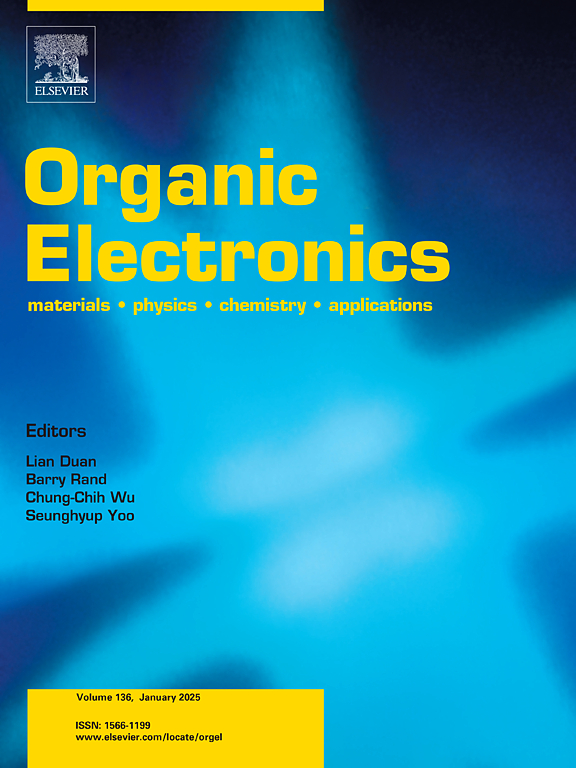Novel near-unity 0D organic-inorganic copper-based halide TEA2Cu2Br4 for high-efficiency and stable ultraviolet photodetectors
IF 2.7
4区 工程技术
Q3 MATERIALS SCIENCE, MULTIDISCIPLINARY
引用次数: 0
Abstract
Low-dimensional copper-based halides have attracted significant attention in the development of ultraviolet photodetectors (PDs) owing to their non-toxic nature, wide band gap, strong light absorption, and long carrier diffusion length. However, the performance of these devices has been constrained by the material's intrinsically low photoluminescence quantum yields (PLQYs), uneven grain size, and agglomeration. In this study, we synthesized a novel 0D copper-based halide [N(C2H5)4]2Cu2Br4 (TEA2Cu2Br4) using a simple solution-based method and demonstrated high-performance ultraviolet PDs based on this material. TEA2Cu2Br4 exhibits a unique dendritic structure with exceptionally long crystals and an outstanding PLQY approaching unity, reflecting a very low trap density and excellent stability. Moreover, the PD device based on TEA2Cu2Br4 crystals achieved remarkably impressive responsivity (R) of 5.07 A/W, high detectivity (D∗) of 7.04 × 1012 Jones, and fast response rates (τr of 11.52 ms and τf of 11.22 ms), demonstrating superior detection capabilities. Notably, the device maintains 90 % of its photocurrent output after 3000 h of aging without encapsulation, highlighting its exceptional stability. This work indicates TEA2Cu2Br4 as an ideal active material for the development of high-performance and stable PDs, offering a promising pathway towards environmentally friendly optoelectronic devices.

新型近统一的0D有机-无机铜基卤化物TEA2Cu2Br4用于高效稳定的紫外光电探测器
低维铜基卤化物具有无毒、宽禁带、强光吸收和载流子扩散长度长的特点,在紫外探测器的研制中受到了广泛的关注。然而,这些器件的性能受到材料本身的低光致发光量子产率(PLQYs),不均匀的晶粒尺寸和团聚的限制。在这项研究中,我们采用简单的溶液为基础的方法合成了一种新型的0D铜基卤化物[N(C2H5)4]2Cu2Br4 (TEA2Cu2Br4),并在该材料的基础上展示了高性能的紫外发光二极管。TEA2Cu2Br4具有独特的枝晶结构,具有超长的晶体和优异的接近统一的PLQY,反映了极低的陷阱密度和优异的稳定性。此外,基于TEA2Cu2Br4晶体的PD器件的响应率(R)为5.07 A/W,探测率(D∗)为7.04 × 1012 Jones,响应率(τr为11.52 ms, τf为11.22 ms)非常快,显示出优越的检测能力。值得注意的是,该器件在没有封装的情况下,在3000小时老化后仍保持90%的光电流输出,突出了其卓越的稳定性。该研究表明,TEA2Cu2Br4是一种理想的活性材料,可用于开发高性能和稳定的pd,为环境友好型光电器件提供了一条有前途的途径。
本文章由计算机程序翻译,如有差异,请以英文原文为准。
求助全文
约1分钟内获得全文
求助全文
来源期刊

Organic Electronics
工程技术-材料科学:综合
CiteScore
6.60
自引率
6.20%
发文量
238
审稿时长
44 days
期刊介绍:
Organic Electronics is a journal whose primary interdisciplinary focus is on materials and phenomena related to organic devices such as light emitting diodes, thin film transistors, photovoltaic cells, sensors, memories, etc.
Papers suitable for publication in this journal cover such topics as photoconductive and electronic properties of organic materials, thin film structures and characterization in the context of organic devices, charge and exciton transport, organic electronic and optoelectronic devices.
 求助内容:
求助内容: 应助结果提醒方式:
应助结果提醒方式:


